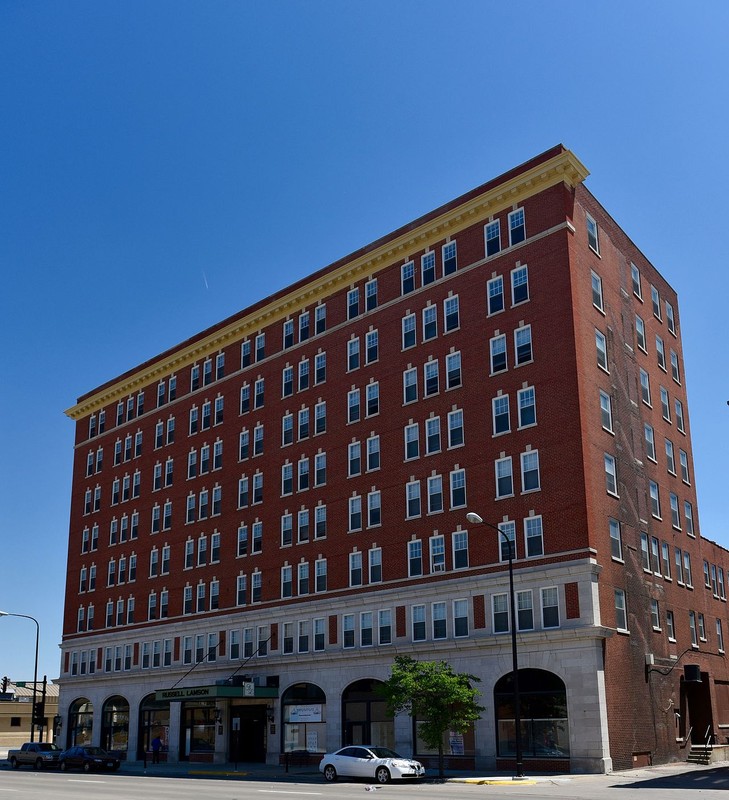Hotel Russell Lamson
Introduction
Text-to-speech Audio
The former Hotel Russell Lawson is one of Waterloo's most important historic landmarks. Erected in 1914, it is significant for its its size, design, and association with the city's industrialization of the early 20th century. In terms of architecture, the building is an excellent example of Classical Revival architecture. Its design is typical of an early 20th-century hotel and it also includes elements of Georgian Revival architecture as well such as keystones, arches on the first floor, and dentils along the cornice. The building housed the offices of an organization called the Greater Waterloo Association, which persuaded industries to come to Waterloo. The hotel was named after its primary investors Clyde O. Lamson and Lillian Russell Lamson. Added to the National Register of Historic Places in 1988, it is now an apartment building.
Images
Now an apartment building of the same name, the former Hotel Russell-Lamson was built in 1914 and remains one of the city's best-known landmarks.

Backstory and Context
Text-to-speech Audio
Increased industrialization development began Waterloo in the 1890s, particularly after an interurban railway line arrived in 1896. Booster organizations on either side of the Cedar River played a large role in attracting businesses and industries to the city through the selling of stocks and lots. The city continued to grow and prosper into the 1920s as a result of this competition. The population increased from 12,580 in 1900 to 26,698 in 1910 and Waterloo became one of the states top manufacturing centers. Agriculture contributed significantly to the economy as well, especially before and during World War I when demand for farm products was high.
Many in the city wanted a modern hotel but it wasn't until Clyde and Lillian Russell-Lamson decided to take on the project in 1912. They sold lots to residents and agreed to use the money raised to help fund the hotel's construction. The Chicago architecture firm Marshall & Fox was hired to design it and when it opened in 1914 it had 250 rooms and 150 private or connecting bathrooms. The hotel also featured billiard tables, a private dining room with a capacity of 100 people, sample rooms for traveling salesmen, a barber shop, an even an artesian well.
The hotel established itself as one of the prestigious buildings in the city. In 1919 rival booster organizations formed the Greater Waterloo Association, which, as noted above, chose the prestigious hotel for its offices. The hotel was also where local radio and television stations originated by a company called Black Hawk Broadcasting Company. On November 4, 1947, the company's first broadcast of radio station KWWL aired from the hotel. The first television broadcast then occurred in 1953. The company moved to a new location in 1958. The hotel operated until the 1960s when it was converted into an apartment building. It was remodeled again in the late 1990s.
Sources
Fisher, Jacqueline. "The Russell-Lamson Hotel." Black Hawk County: Past and Present. University of Northern Iowa. Accessed September 7, 2021. https://historyofBlackhawkcounty.uni.edu/cultdailylife/Russell-Lamson/RussellAndLamson.htm
Jacobsen, Chief James. "Historical and Architectural Resources of Waterloo, Iowa." September 8, 1988. https://npgallery.nps.gov/NRHP/GetAsset/NRHP/64500187_text.
Jacobsen, James E. "Hotel Russell Lamson." National Park Service - National Register of Historic Places Nomination Form. November 29, 1988. https://npgallery.nps.gov/NRHP/GetAsset/NRHP/88001324_text.
Jim Roberts, via Wikimedia Commons: https://commons.wikimedia.org/wiki/File:Hotel_Russell-Lamson.jpg
